Is it boring? It's not Provence.
http://www.goodfoodworld.com/2011/09/is-it-boring-its-not-provence/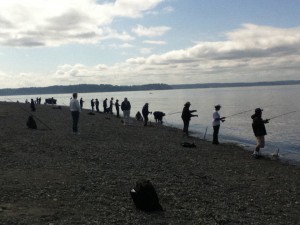
Pole Fishing at Lincoln Park
“The question—’Is it boring?’—is not one that people would ask about local eating in Provence or Thailand or Cajun Country, Louisiana.”
Plenty, Alisa Smith and J.B. MacKinnon, pg. 89.
I think most people—even those committed to local food—look for retail stores and farmers markets where they can buy food. Growing, foraging, gleaning, trading, and organizing or shopping through cooperatives seem to take more time than trips to the grocery store. But I found something that looked so easy and it was so immediate that I wondered if more people should give it a try.
In late August, I went for a walk on the beach side of Lincoln Park in West Seattle. Accessed by a short residential road, a rocky beach and paved walkway sitting at the base of the bluff; this beach is usually peopled by few. Walking in, I passed a man leaving with a fishing pole and a rolling rack full of gear. I didn’t think much of it until I saw at the far end of the beach about forty people casting right off the shore. I know that people occasionally fish for perch this way but I was astounded to see so many people fishing in a recreational park I had first visited thirty years ago—when there were no fishermen.
I quickly concluded they were fishing for food for their tables but that may have been too quick of a judgment. I stepped off the walkway to see what they were catching. As I passed them, the few fishermen who were willing to turn their heads away from the water and answer questions said there was a run of six million pink salmon coming through Puget Sound on their biannual spawning run.

Women were a bit unusual in this crowd.
Some of the people appeared to be immigrants and it was clear that they spoke English as a second language but when I asked them, most said it was for the sake of fishing and that sport fishing was for food when it came to these salmon. I asked one of the two women there how she had learned to fish and she cheerfully said that at first the men taught her the basics of fishing then she just figured things out. The fishing looked great. In any case, all the ramifications of finding a source of quality seafood 2 miles from my home came to mind.
I called Kurt Beardslee, who heads The Wild Fish Conservancy, a non-profit fish advocacy group in Duvall, to get some of the background on pinks. His comments were careful. He said that while the pinks are one of the larger runs, he was concerned that if too many were caught before they got back to the rivers, the fishery couldn’t be sustainable.
Cleaning Fish in the surf.
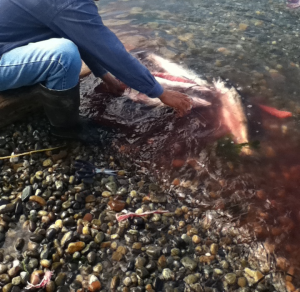
Pink salmon, he said, had a simpler life cycle than other species like Chinook and were more adaptive in finding spawning habitat. (He used the biological term “escapement” to describe the numbers that did succeed in passing into the river and I thought that was ironic. They have to escape to their homes to survive.)
Another concern that he had was of getting nutrients back into the river. One of the great benefits of the huge salmon runs of the past was that the carcasses left after spawning brought nutrients back to the entire river system. However, even with the number of the pink salmon that is now returning there would not be enough nutrient loading.
In addition, pink salmon, by not having been favored in the past, were not as highly prized commercially so populations weren’t depleted as much by commercial fishing as with Chinook and other species. Now that there are more restrictions on other species of salmon, he was waiting to see how much commercial activity there was for the pinks.
I wondered: If driven by need, how many local food advocates would be willing to go to the shores of Puget Sound in late summer and catch their dinner? I did some research. The costs of supplies that one man elicited on the Seacrest Pier in West Seattle the following Thursday would be about $100. Add to that a $28.05 fishing license for individuals aged 16-69. At about $5.50 a pound in local stores on the low end and 3-4 pounds per fish if one were to catch 3 fish in a day (which many on the beach were) the catch would be around $60 worth of fish in a day. So, two days of good fishing would almost offset the cost of setup and they’d be harvesting 100-mile fish.
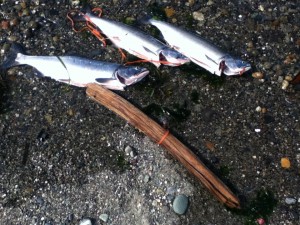
Day's Catch
I’m generally more in favor of coordinated efforts when it comes to natural resources. I can’t not wonder about the impacts if everyone fished the salmon runs without constraint. Most people who fish are conscientious and if their numbers were not too large they might not shift the balance further away from protection of key species in our rivers and water ecosystems. However, we seem as a society often not to have that constraint. So a year in which we are having an abundance of pink salmon may be a good time to think about ways to coordinate the fishery. How could we support protection and sustainability of all species and if there could be a sustainable fishery, what would it look like?
Walking Fish CSF
I found another way to harvest fish that I liked very much. It is the idea of a community supported fishery (CSF) much like a CSA in concept. This has been done in other parts of the country where fisheries have been depleted and communities at a loss for sustenance have gotten together to harvest the fish in a manageable way. A good example is the Walking Fish Cooperative in North Carolina. They are in their third year of operating and have just this year become a cooperative. This seems like an idea that many in the Seattle area would embrace.
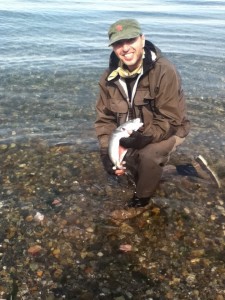
Successful Fisherman "Samih" fishes for sport all the time.
Just by chance an article by Lynda Mapes for the Seattle Times on September 13 offered a possible fishing method for a sustained local fishery: reef netting. Human powered and low tech, this approach takes watchful waiting and hand-thrown nets. The fishermen carefully select which fish they take out of the net and keep and they avoid “by-catch” by pushing away anything they are not supposed to catch. If the independent fisherman practicing this technique were to coordinate their work with a group organized as a cooperative, it could be a healthy step in both resource management and developing a sustained food supply.
The pink salmon are now moving into the rivers and the Coho and Chinook runs are starting. I am sure that many individuals will continue to fish on the shores of Puget Sound and the rivers for both the ocean and upstream catches. Many will opt for the choice of standing for hours on the beach for more than just a source of food. Fishing provides time, a connection to a place and a chance to renew relationships both spiritual and ecological. It’s good for them and all of us to be reminded of those connections.
I love that Alisa and J.B. of Plenty ultimately did survive for a year on their 100-mile diet and I might try taking a pole out myself to fish for the food and the contemplative time by the water. I hope it will be another piece of working for the greater good of the whole food and ecosystem here, now and over time—and it definitely won’t be boring even if it isn’t Provence!
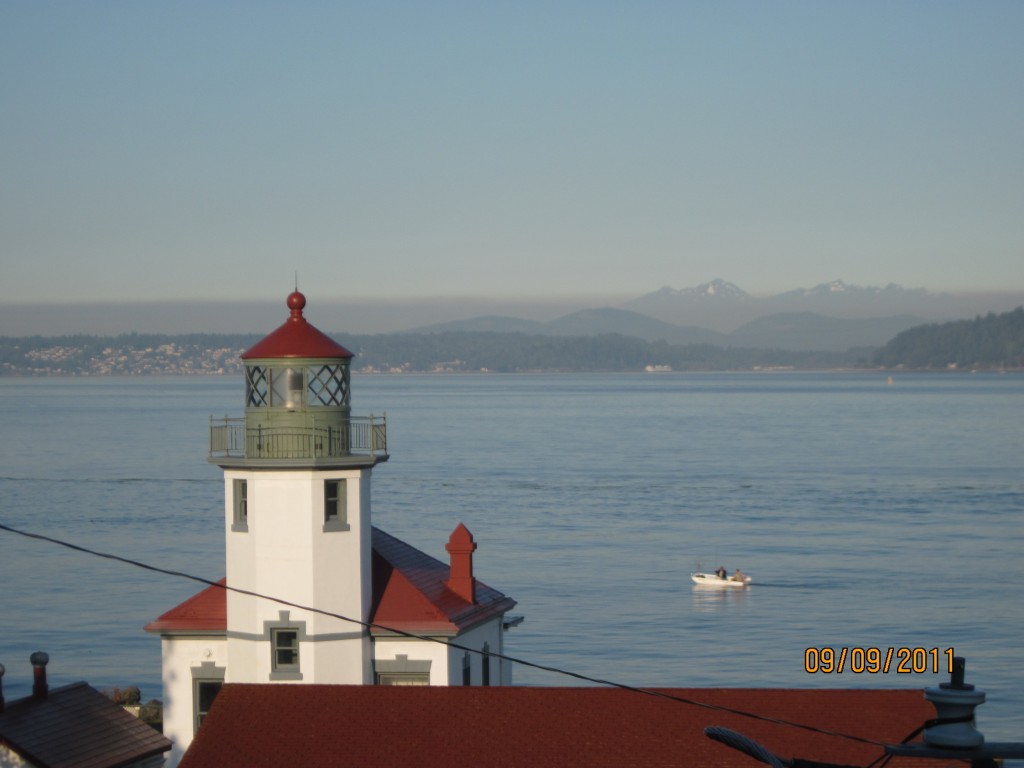
From my window: Some people fish in small boats as well. Perhaps they could be part of a Coop.